Saturday, July 27, 2019
Weekly Indicators for July 22 - 26 at Seeking Alpha
- by New Deal democrat
My Weekly Indicators post is up at Seeking Alpha.
The short leading indicators have been particularly noisy recently, and they changed again in the past week.
As usual, clicking over and reading not only should be educational for you, but helps reward me with a penny or two for my efforts.
Friday, July 26, 2019
Both long leading components of Q2 GDP declined UPDATED with revisions and further comments
- by New Deal democrat
The headline number for the first estimate of real GDP in Q2 2019 was 2.1%, as I’m sure you’ve read elsewhere.
As is usual, I’m not so interested in what is, after all, what the view in the rear view mirror is, as what the leading components can tell us about what lays ahead.
In that regard, both leading components of GDP declined.
- Real private fixed residential investment declined at a -1.5% rate annualized. This is the 6th quarter in a row of a decline in that number. In the past half century, declines this long have typically been seen either right before or right after a recession has started - although the magnitude of the decline has been smaller.
UPDATE: Here is private fixed residential investment measured both nominally and in real terms as a share of GDP:
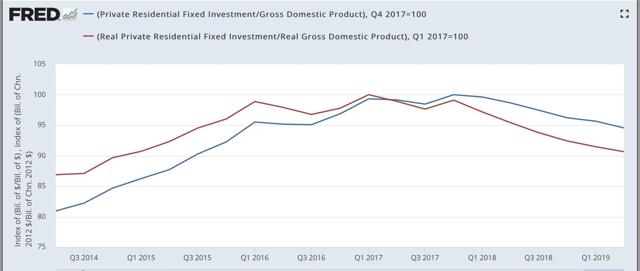
UPDATE: Here is private fixed residential investment measured both nominally and in real terms as a share of GDP:

Nominally this is down about 5% from peak; in real terms about 10%. This is far short of what is typically the case typically going into recessions, but it *is* on par with the producer-led 2000-01 period.
- Proprietors income (a proxy for the more reliable corporate profits, which won’t be released until next month) rose 0.6% nominally. Since the GDP deflator rose 2.2%, this means that “real” proprietors income declined. UPDATE: the 2.2% figure was annualized. Thus the “real” number was essentially flat, but is below its recent peak of Q4 2018:
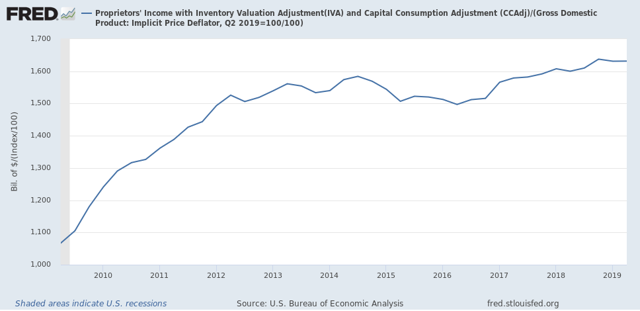

I will update later once graphs are available. For now, the important takeaway is that one long leading indicators in the GDP release declined, and the second was flat but below peak level, *consistent with* (but not necessarily implying) a recession either being imminent, or possibly not occurring until next year.
Thursday, July 25, 2019
Initial claims ending July 20: still positive
- by New Deal democrat
I have started to monitor initial jobless claims to see if there are any signs of stress.
My two thresholds are:
1. If the four week average on claims is more than 10% above its expansion low.
2. If the YoY% change in the monthly average turns higher.
Here’s this week’s update.
My two thresholds are:
1. If the four week average on claims is more than 10% above its expansion low.
2. If the YoY% change in the monthly average turns higher.
Here’s this week’s update.
Initial jobless claims last week were 206,000. This is close to the bottom range for the past 18 months. As of this week, the four week average is 5.0% above its recent low:
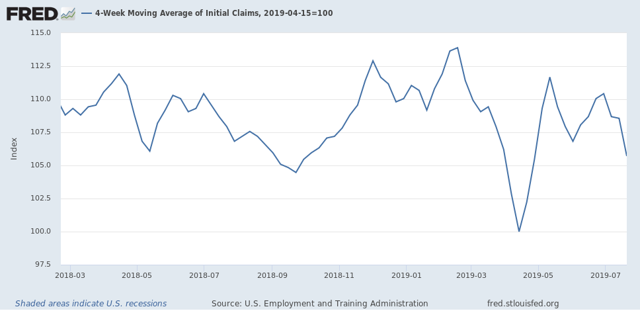
and at 213,000, is 4,500, or -2.1%, lower than this week last year:
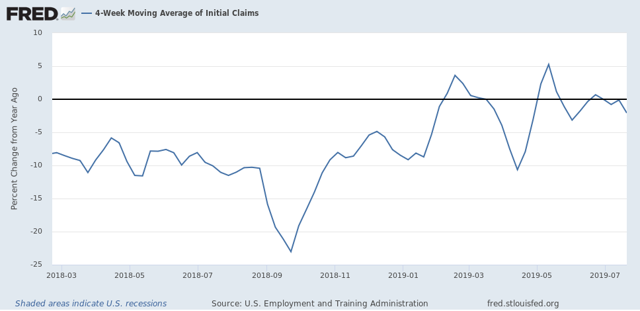
This remains positive.
Last July, initial claims averaged 215,250. Through the first three weeks, it is 210,000 this year, which is also positive:
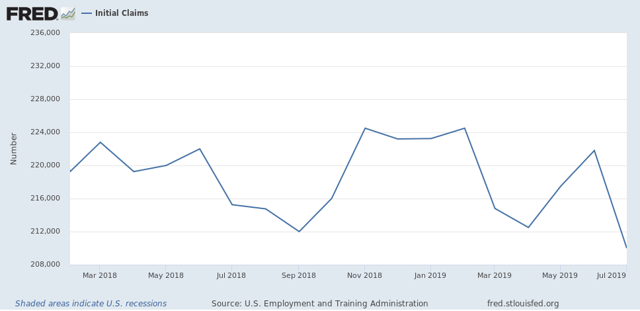
Claims in the final week would have to be about 230,000 or higher for the entire month of July to be negative (higher) YoY.
Finally, let’s compare the YoY% change in initial claims (blue) with continuing claims (red):
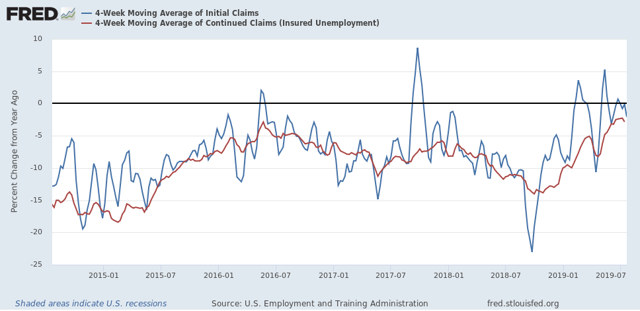
Comparisons have been getting closer to crossing the threshold from lower to higher, but for the past two weeks have trended a little mobster. This. week the comparison was -2.9% YoY. A longer term view continues to show that - so far - this is most consistent with the 1984, 1994, and 1996 slowdowns, and not a recession:
Wednesday, July 24, 2019
Housing has bottomed
- by New Deal democrat
With the release of new home sales this morning, and existing home sales yesterday, it is increasingly apparent that housing has bottomed - just as I said a number of months ago that it would sometime this spring.
To the graphs! New home sales (blue in the graph below) bottomed last October, at 557,000 units annualized. As of June, they were at 646,000:
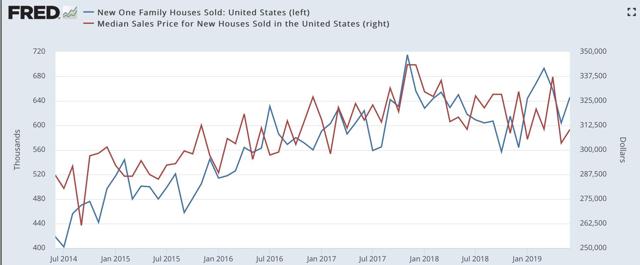
This isn’t as good as earlier this spring, but is better than every other reading in the past 12 months. Meanwhile prices, which typically lag sales, bounced back from May’s 12 month low, but it is not clear at all if the trend is reversing yet.
Here’s the same data presented YoY, so that it is easier to see the trend:
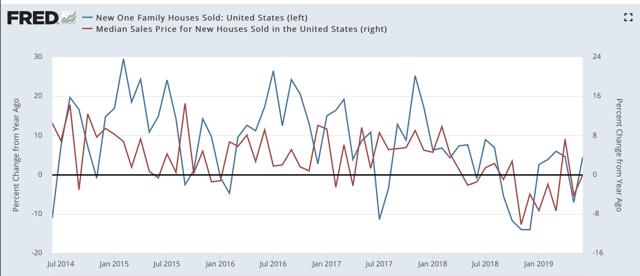
Both sales and prices have bounced back to positive (sales) or unchanged (prices) YoY from their worst comparisons last autumn.
Meanwhile existing home sales declined m/m, but have clearly rebounded off their lows five months ago:
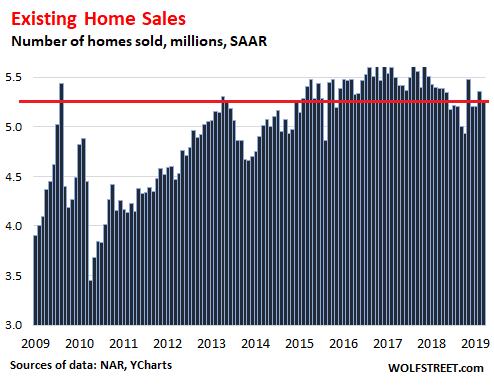

And prices of existing homes, which aren’t seasonally adjusted, rose 4.3% YoY:
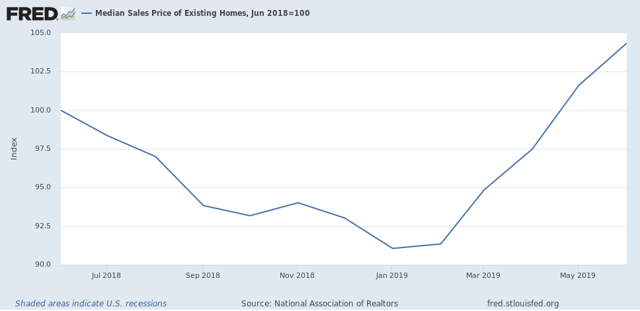
At this point the only home sales metric which has not come back from lows is total housing permits, which made a new low in June, due to a big downturn in the very volatile multi-unit permits. Single family permits, which are a less volatile and more reliable metric, are above their low from two months ago. [See my discussion last week.]
In short, lower mortgage rates have put a bottom beneath the housing market.
Tuesday, July 23, 2019
My forecast for the rest of 2019 is . . . .
- by New Deal democrat
. . . up at Seeking Alpha!
I’ll be doing my long term forecast through mid year 2020 once Q2 GDP comes out on Friday. It’ll probably get posted sometime next week.
P.S. Sorry for the lack of posting yesterday. I submitted the above to SA on Sunday, but they didn’t get around to putting it up until late yesterday afternoon. If I have the energy, I’ll put up an extra post maybe this afternoon.
Sunday, July 21, 2019
How today’s Democratic ‘Squad’ is a direct ideological descendant of the original 1850s Republicans
- by New Deal democrat
Nothing is ever really “new.” Today’s ‘Squad’ of young Democrats is the direct ideological descendant of the original 1850s Congressional Republicans. That is one of the important lessons of Joanne Freeman’s “The Fields of Blood,” about the increasing threats of, and actual incidents of, violence in the US Congress between the 1830s and the Civil War.
Just as today, there were differing economic and social divides in America. Economically there was a struggle for power between the merchant class and farmers. Socially the increasingly contentious issue was that of slavery. At least beginning with Andrew Jackson’s 1828 Presidential election victory, the Democratic Party was the voice of farmers. The ex-Federalists and the nascent Whig party became that of commerce.
But there were northern and southern branches of each party, defined in how they stood on slavery. The story of the 1830s through 1850s is how that moral issue moved to the forefront, splitting both parties, and ultimately giving rise to the Republicans. This is very much the same paradigm as the “great sort” that took place between the Democratic Party and the GOP between 1980 and 2016 (if not 2008).
Not only is that, but reminiscent of polls over the past 10 years, in the 1830s and 1840s northerners, especially northern Whigs, wanted to settle disputes civilly, while especially southern Democrats were willing to threaten, and even use, physical force to get their way.
Most importantly, dueling was accepted in the south as a way to defend one’s “honor,” while in the north it was looked upon as unseemly. Southerners used this to their advantage, knowing that northerners would back down in the face of a challenge to a duel. This first came to a head when, in 1838, Maine Representative Jonathan Gilley accepted the challenge of Kentucky Representative Williams Graves. Neither really wanted to duel, and both were poorly served by their seconds, who at crucial moments failed to resolve the situation, but the bottom line is that Graves shot and killed Gilley. Sectional debate on the floor of Congress had finally gone all the way to causing a death.
And just as in our present era, one side was especially willing to break norms in order to get their way on their biggest issues. One analog to Mitch McConnell now was James K. Polk, who promised in 1844 that he would lower tariffs that hurt farmers, acquire California and the Oregon territory, and allow Texas into the Union. Of course, a big reason for the acquisition of southwestern lands was to allow the expansion of slavery to new states, which is why both the venerable John Quincy Adams and a young Abraham Lincoln opposed the Mexican War. A second norm-breaker was Stephen Douglas, who blew up the Missouri Compromise even before the Dred Scot case, advocating that territories themselves should choose whether they would allow slavery or not, which ultimately succeeded in the Kansas-Nebraska Act.
Finally the north had had enough, and elected Representatives and Senators who vowed not to be cowed. Here is Freeman’s discussion of the arrival of the first Republicans elected to Congress in 1855:
As inchoate as this new party was, the arrival of an explicitly Northern opposition had an enormous impact on Congress. Not only did the number of fights spike precipitously after 1855, but their dynamics fundamentally changed. Republicans promoted themselves as a new kind of Northerner who was willing to fight back, and they were true to their word. They fought to wrest control of Congress and the Union from the Slave Power.
As an example, Freeman cites the contest for Speaker in 1859. Southerners threatened violence if a Northerner won the post. Pennsylvania Republican Thaddeus Stevens
said that he didn’t blame Southerners for their threats, ‘for they have tried it fifty times, and fifty times they have found weak and recreant tremblers in the North who have been affected by it.’ When Stevens’ quip brought [Georgian] Martin Crawford to his feet uttering threats, Stevens added, ‘That is right. That is the way that they frightened us before.’ At this, Crawford headed toward Stevens .... Within seconds, Republicans and Southern Democrats were rushing down the aisles, several of them reaching for guns.
In addition to the famous caning by Sen. Preston Brooks of Sen. Charles Sumner, there were more than a dozen fights in the Thirty-Sixth Congress. In one incident, Southern Democrat Roger Pryor challenged Republican John Potter to a duel. He was surprised when Potter not only accepted but chose Bowie knives as weapons. Pryor backed down, citing the “vulgarity” of the weapon, and northerners rejoiced.
As Freeman notes, Republicans “did so with an approving Northern public looking on.” Meanwhile, shocked Democrats reacted with apoplexy to the Republican challenge, caricaturing them as lunatics and radicals.
A political faction entrenched in power for a generation or more being challenged by new generation of implacable opposition sounds exactly like the reaction of the GOP to the ‘Squad’ today.
Just as then, I believe that the new unwavering and determined opposition will ultimately carry the day, although it may be done “one funeral at a time.” But also just as then, I wonder how big a Constitutional rupture may occur along the way.
Subscribe to:
Comments (Atom)